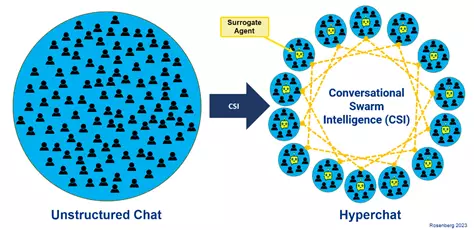In today’s fast-paced world, organizations constantly seek innovative ways to leverage collective intelligence. Imagine a large group of 200 individuals participating in a meaningful, real-time discussion where brainstorming flows seamlessly, knowledge is rapidly shared, and decisions are made with unprecedented efficiency. This scenario may sound too good to be true, yet breakthroughs in generative AI are paving the way for such transformative interactions. Enter hyperchat technology—an advanced form of conversational swarm intelligence—that promises to enable large teams to communicate effectively, converging quickly on solutions optimized by artificial intelligence.
The standard approach to group discussions typically limits productive dialogue to smaller teams, where effective communication thrives. Traditional research suggests that groups larger than seven often devolve into chaos, leading to frustration rather than productive output. Conversely, hyperchat addresses this challenge head-on by breaking large teams into manageable subgroups, integrating AI agents that facilitate communication and knowledge sharing across these clusters. The potential applications of this technology in various professional environments are enormous, particularly as organizations grow in size and complexity.
The Experiment: A Real-World Application
To demonstrate the efficacy of hyperchat technology, a groundbreaking experiment was executed by Unanimous AI, bringing together a cohort of 50 randomly selected sports fans. The challenge? To collaboratively develop a March Madness basketball bracket using the Thinkscape platform, engineered for optimized deliberation. The significance of this experiment lies not only in the task itself, but also in the potential of blending human ingenuity with AI optimization.
While conventional wisdom might suggest gathering a larger group in a chat room to collaborate, this approach would likely yield diminishing returns. Hyperchat technology, however, allows for each subgroup to function autonomously while still contributing valuable insights to the larger team dynamic. The AI agent—termed a “conversational surrogate”—synthesizes the output from local groups and transmits distilled ideas back to the collective. Remarkably, the bracket curated through this method outperformed 99% of other entrants in the ESPN March Madness contest, achieving a notable ranking in the top 1.4%.
The success of this initial experiment unfolds a compelling narrative about the power of collaborative intelligence when harnessed correctly. More than just an impressive feat, it underscores the potential that AI-driven conversational platforms have in revolutionizing how we engage in decision-making.
Scientific Insights and Enhanced Performance
Research backings clarify how hyperchat configurations can dramatically uplift group performance. For instance, a study conducted by Carnegie Mellon and Unanimous AI found that groups employing hyperchat configurations achieved an “effective IQ” of 128, translating to gifted-level performance—a remarkable leap from their baseline scores. These findings illustrate an extraordinary potential of technology: the amplification of reasoning and idea generation through systematic, aggregated dialogue.
Additionally, participants engaged in brainstorming sessions reported higher productivity, stronger collaboration, and a deeper sense of ownership over the solutions developed in hyperchat compared to conventional chatting methods. With such data illuminating the vast disparity in outcomes, it becomes apparent that the framework of hyperchat can redefine not only the capacity for dialogue but also the quality of that dialogue.
The hybridization of human intelligence with AI through the inclusion of a “contributor agent” is particularly noteworthy. These AI components enrich discussions by providing relevant, real-time information that supports human deliberation. The experimentation involving fantasy baseball teams illustrated that as teammates collaborated with AI assistance, decision-making quality significantly improved, bolstering the validity of hyperchat as a transformative collaborative approach.
Transformative Potential for Organizations
With the average Fortune 1000 company harboring tens of thousands of employees, the potential impact of hyperchat technology on organizational productivity is nothing short of revolutionary. For years, the bottleneck of real-time deliberation limited to small groups posed challenges that many organizations struggled to overcome. Hyperchat technology abolishes this constraint, offering solutions that are not only efficient but also inclusive of human input.
As organizations consider the integration of AI technologies, embracing hybrid models of decision-making might be the key to future success. The controlled involvement of AI in human dialogues could foster a new era of optimized, equitable decision-making processes while ensuring that human insight remains at the forefront. The findings from the March Madness experiment and associated studies serve as a testament to this revolutionary approach, framing a compelling argument for widespread adoption.
In the continually evolving landscape of workplace dynamics, the future belongs to those who can adeptly harness technology to elevate human potential. Hyperchat, as it stands, is heralding a new era for teamwork by redefining how we collaborate, innovate, and, ultimately, thrive in a collective environment.

